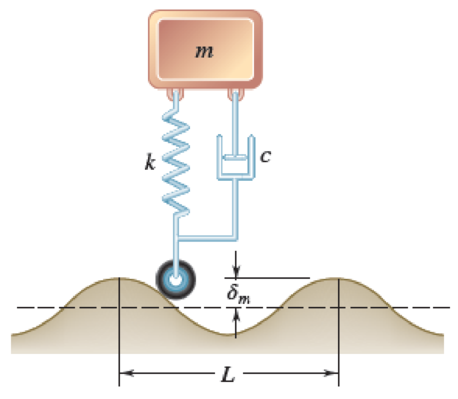
Concept explainers
The suspension of an automobile can be approximated by the simplified spring-and-dashpot system shown. (a) Write the differential equation defining the vertical displacement of the mass m when the system moves at a speed v over a road with a sinusoidal cross-section of amplitude δm and wavelength L. (b) Derive an expression for the amplitude of the vertical displacement of the mass m.

Fig. P19.151
(a)
Write the differential equation defining the vertical displacement of the mass m when the system moves at a speed v over a road with a sinusoidal cross section of amplitude
Answer to Problem 19.151P
The differential equation defining the vertical displacement of the mass m when the system moves at a speed v over a road with a sinusoidal cross section of amplitude
Explanation of Solution
Calculation:
Show the free body diagram of the system of automobile, spring and dashpot as in Figure (1).

The expression for the weight of the automobile (W) as follows:
Here,
The expression for the acceleration of the automobile (a) as follows:
Refer Figure (1),
The expression for the force by considering the vertical equilibrium condition as follows;
Substitute
Substitute
The expression for the time interval needed to travel
The expression for the forced circular frequency
Substitute
The expression for the motion of the wheel which is sine curve
Differentiate the above equation with respect to time ‘t’.
Substitute
Substitute
Therefore, the differential equation defining the vertical displacement of the mass m when the system moves at a speed v over a road with a sinusoidal cross section of amplitude
(b)
Derive an expression for the amplitude of the vertical displacement of the mass m.
Answer to Problem 19.151P
The expression for the amplitude of the vertical displacement of the mass m is
Explanation of Solution
Calculation:
The expression for the general solution from the identity as follows:
Here,
The expression for the force transmitted (F) to the automobile as follows:
Substitute
The expression for the differential equation of the motion for the damped forced vibration as follows:
Compare the equation (3) and (4).
The expression for the steady state of motion of the system as follows:
The expression for the steady state of motion of the system as follows:
Substitute
The expression for the phase angle
The expression for the Eulerian angle
Therefore, the expression for the amplitude of the vertical displacement of the mass m is
Want to see more full solutions like this?
Chapter 19 Solutions
VECTOR MECH...,STAT.+DYN.(LL)-W/ACCESS
- pls solvearrow_forward+1. 0,63 fin r= 0.051 P The stepped rod in sketch is subjected to a tensile force that varies between 4000 and 7000 lb. The rod has a machined surface finish everywhere except the shoulder area, where a grinding operation has been performed to improve the fatigue resistance of the rod. Using a 99% probability of survival, determine the safety factor for infinite life if the rod is made of AISI 1080 steel, quenched and tempered at 800°c Use the Goodman line. Does the part fail at the fillet? Explainarrow_forwardSolve this problem and show all of the workarrow_forward
- I need drawing solution,draw each one by one no Aiarrow_forwardQu. 17 Compute linear density values for [100] for silver (Ag). Express your answer in nm''. . Round off the answer to three significant figures. Qu. 18 Compute linear density value for [111] direction for silver (Ag). Express your answer in nm'. Round off the answer to three significant figures. Qu. 19 Compute planar density value for (100) plane for chromium (Cr). Express your answer in nm?. Round off the answer to two significant figures. Qu. 20 Compute planar density value for (110) plane for chromium (Cr). Express your answer in nm ≥ to four significant figures. show all work please in material engineeringarrow_forward3-142arrow_forward
- I need solutionsarrow_forward3-137arrow_forwardLarge wind turbines with a power capacity of 8 MW and blade span diameters of over 160 m areavailable for electric power generation. Consider a wind turbine with a blade span diameter of 120m installed at a site subjected to steady winds at 8.25 m/s. Taking the overall efficiency of thewind turbine to be 33 percent and the air density to be 1.25 kg/m3, determine the electric powergenerated by this wind turbine. Also, assuming steady winds of 8.25 m/s during a 24-h period,determine the amount of electric energy and the revenue generated per day for a unit price of$0.08/kWh for electricity.arrow_forward
 Elements Of ElectromagneticsMechanical EngineeringISBN:9780190698614Author:Sadiku, Matthew N. O.Publisher:Oxford University Press
Elements Of ElectromagneticsMechanical EngineeringISBN:9780190698614Author:Sadiku, Matthew N. O.Publisher:Oxford University Press Mechanics of Materials (10th Edition)Mechanical EngineeringISBN:9780134319650Author:Russell C. HibbelerPublisher:PEARSON
Mechanics of Materials (10th Edition)Mechanical EngineeringISBN:9780134319650Author:Russell C. HibbelerPublisher:PEARSON Thermodynamics: An Engineering ApproachMechanical EngineeringISBN:9781259822674Author:Yunus A. Cengel Dr., Michael A. BolesPublisher:McGraw-Hill Education
Thermodynamics: An Engineering ApproachMechanical EngineeringISBN:9781259822674Author:Yunus A. Cengel Dr., Michael A. BolesPublisher:McGraw-Hill Education Control Systems EngineeringMechanical EngineeringISBN:9781118170519Author:Norman S. NisePublisher:WILEY
Control Systems EngineeringMechanical EngineeringISBN:9781118170519Author:Norman S. NisePublisher:WILEY Mechanics of Materials (MindTap Course List)Mechanical EngineeringISBN:9781337093347Author:Barry J. Goodno, James M. GerePublisher:Cengage Learning
Mechanics of Materials (MindTap Course List)Mechanical EngineeringISBN:9781337093347Author:Barry J. Goodno, James M. GerePublisher:Cengage Learning Engineering Mechanics: StaticsMechanical EngineeringISBN:9781118807330Author:James L. Meriam, L. G. Kraige, J. N. BoltonPublisher:WILEY
Engineering Mechanics: StaticsMechanical EngineeringISBN:9781118807330Author:James L. Meriam, L. G. Kraige, J. N. BoltonPublisher:WILEY





